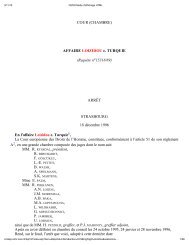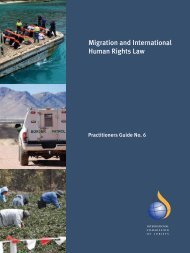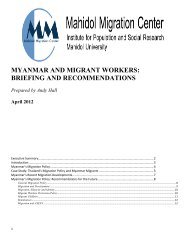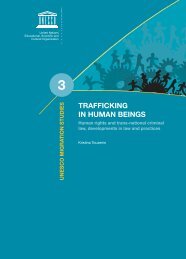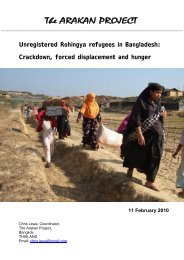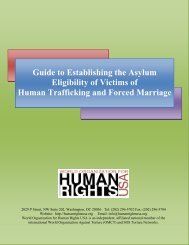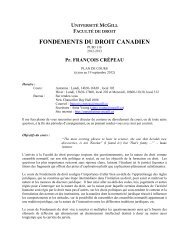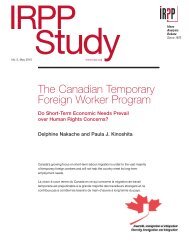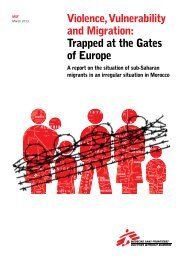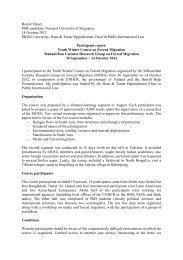Access to Justice for Migrant Workers in BC - West Coast Domestic ...
Access to Justice for Migrant Workers in BC - West Coast Domestic ...
Access to Justice for Migrant Workers in BC - West Coast Domestic ...
You also want an ePaper? Increase the reach of your titles
YUMPU automatically turns print PDFs into web optimized ePapers that Google loves.
PART ONE<br />
The Global Shift Toward Temporary Foreign <strong>Workers</strong><br />
S<strong>in</strong>ce the turn of the century, Canada has moved <strong>in</strong>creas<strong>in</strong>gly <strong>to</strong> an immigration model<br />
that prioritizes the import of temporary <strong>for</strong>eign workers. In do<strong>in</strong>g so, it is mirror<strong>in</strong>g the trend<br />
that has developed globally. 2 Many countries are heavily dependent on the import of<br />
temporary labour. Indeed, there has been a dramatic growth <strong>in</strong> temporary worker programs<br />
globally, particularly <strong>in</strong> Organization <strong>for</strong> Economic Co-operation and Development (OECD)<br />
countries. 3 About 2.5 million temporary workers entered OECD countries <strong>in</strong> 2006, which<br />
was roughly three times the number of workers who entered on a permanent basis. 4<br />
Temporary migration of <strong>for</strong>eign workers, <strong>in</strong><strong>to</strong> OECD countries, has <strong>in</strong>creased by 4% <strong>to</strong> 5%<br />
per year s<strong>in</strong>ce 2000. 5 Related <strong>to</strong> this trend has been a shift <strong>to</strong>ward migration policy driven<br />
by employer requests or job offers as opposed <strong>to</strong> government macro-policy. Derrick<br />
Thomas, edi<strong>to</strong>r of a 2010 Statistics Canada report, has noted the appeal of temporary<br />
migrant worker programs <strong>to</strong> governments. Such programs give governments the flexibility<br />
and allow them <strong>to</strong> m<strong>in</strong>imize costs. As Thomas states,<br />
“Temporary worker programs are attractive because they enable countries <strong>to</strong> quickly<br />
address labour market needs <strong>in</strong> an expand<strong>in</strong>g economy without the <strong>in</strong>creased costs<br />
associated with ma<strong>in</strong>ta<strong>in</strong><strong>in</strong>g unemployed workers dur<strong>in</strong>g a downturn - the costs<br />
associated with social and economic <strong>in</strong>tegration are also reduced.” 6<br />
Canada’s migration trends have mirrored the global phenomenon highlighted by the<br />
OECD’s figures. The <strong>in</strong>flux of temporary <strong>for</strong>eign workers enter<strong>in</strong>g Canada has <strong>in</strong>creased<br />
dramatically s<strong>in</strong>ce 2006. 7 Government policy clearly outl<strong>in</strong>es this approach through the<br />
2007 budget document which stated, “it is our government’s <strong>in</strong>tention <strong>to</strong> create the best<br />
2<br />
Karl Flecker, “Build<strong>in</strong>g a Disposable Work<strong>for</strong>ce Through Temporary Migration Policy,” Canadian Issues Spr<strong>in</strong>g (2010): 101, http://<br />
search.proquest.com.ezproxy.library.ubc.ca/docview/610780614accountid=14656.<br />
3<br />
OEDC members: Australia, Austria, Belgium, Canada, Chile Czech Republic, Denmark, Es<strong>to</strong>nia, F<strong>in</strong>land, France, Germany,<br />
Greece, Hungary, Iceland, Ireland, Israel, Italy, Japan, Korea, Luxembourg, Mexico, Netherlands, New Zealand, Norway, Poland,<br />
Portugal, Slovak Republic, Slovenia, Spa<strong>in</strong>, Sweden, Switzerland, Turkey, United K<strong>in</strong>gdom, United States.<br />
4<br />
Karl Flecker, “Build<strong>in</strong>g a Disposable Work<strong>for</strong>ce Through Temporary Migration Policy,” Canadian Issues Spr<strong>in</strong>g (2010): 101, http://<br />
search.proquest.com.ezproxy.library.ubc.ca/docview/610780614accountid=14656.<br />
5<br />
Manolo Abella, “Policies and Best Practices <strong>for</strong> Management of Temporary Migration,” Population Division, Department of<br />
Economic and Social Affairs, United Nations Secretariat. (2006): 8 http://cronus.uw<strong>in</strong>dsor.ca/units/socialjustice/ma<strong>in</strong>.nsf/<br />
982f0e5f06b5c9a285256d6e006cff78/a9fee0f9ae7e1026852573d40063d1e5/$FILE/TempMigration.pdf.<br />
6<br />
Canada. Statistics Canada. Foreign Nationals Work<strong>in</strong>g Temporarily <strong>in</strong> Canada. Edited by Derrick Thomas. (Ottawa, Ont.), 2010.<br />
Modified 2010.06.08 http://www.statcan.gc.ca/pub/11-008-x/2010002/article/11166-eng.htm.<br />
7<br />
Karl Flecker, “Build<strong>in</strong>g a Disposable Work<strong>for</strong>ce Through Temporary Migration Policy,” Canadian Issues Spr<strong>in</strong>g (2010): 101, http://<br />
search.proquest.com.ezproxy.library.ubc.ca/docview/610780614accountid=14656.<br />
8



